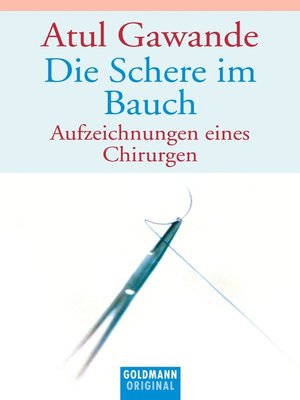
Complications: A Surgeon's Notes on an Imperfect Science is a collection of stories based on the experiences of a surgical resident at a major teaching hospital in Boston. The author, Atul Gawande, M.D., presents a refreshingly humanistic approach to both surgery and to the care of patients in general. This book is for all readers, medical and nonmedical, young and old alike. In fact, even my 17-yr-old, thinks-he-wants-to-be-a-doctor, son is engrossed in the book. Killa Tay Snake Eyes more.

Atul Gawande's training began with a bullet wound and ended with a flesh-eating bug. He reports back from the medical front line in Complications. Atul Gawande is the author of The Checklist Manifesto and Better. Complications was a National Book Award finalist. He is also a MacArthur Fellow, a general surgeon.
The central tenet of the book is that medicine is an imperfect profession. Physicians are not without failures, which include personal, professional, and technical shortcomings, and individual chapters address each of these sensitive issues.
Moreover, patients are human, and thus imperfect, too. A technically perfect operation does not always produce a good outcome.
Patients do not always comply with their physician's advice. While hoofbeats usually mean horses, occasionally a zebra will appear. And just as physicians do not always make wise decisions, patients in kind often fail to act in their own best interests. The writing style is crisp, concise, and skillful. Gawande, a regular contributor of science and medical articles to The New Yorker, demystifies complex topics of anatomy, physiology, and pharmacology in a manner that is technically correct and understandable by those with limited or no medical background, while still maintaining an air of compassion. In the chapter entitled “A Queasy Feeling,” we read a marvelous description of the physiology of nausea and vomiting, but the reader also experiences a personal glimpse into the hellacious suffering of a woman experiencing a pregnancy complicated by unrelenting hyperemesis gravidarum. Anyone who has ever had their face turn red in a social situation will identify with the predicament described in the chapter “Crimson Tide,” the saga of a television news broadcaster whose very livelihood is threatened by frequent, severe, and unprovoked blushing.
What follows is not only a superb description of the physiology of blushing, and a surgical procedure uniquely developed to cure this problem, but also moral and teleologic implications of this universal human emotion. Other chapters address topics such as “flesh-eating” bacterial infection, morbid obesity and the development of bariatric surgery, the care of the terminally ill patient, medical research and informed consent, and the role of the autopsy in modern-day medical care. Much in this book involves topics directly related to anesthesiology.
The opening chapter, “Education of a Knife,” will ring true to every anesthesia resident, as the author meticulously describes the learning process of becoming proficient at central line insertion. The surgical intern describes watching his senior resident:“She drew back on the syringe. And she was in. You know because the syringe filled with maroon blood. ‘If it's bright red, you've hit an artery,’ she said.
‘That's not good.’” (p 12) The theme of central line insertion, however, is merely metaphor, as this chapter delves into much deeper concepts of medical education—how residents learn and how attending physicians or senior residents teach. “When Doctors Make Mistakes” is a tribute to the specialty of anesthesiology, describing the advances in patient safety and monitoring developed by anesthesiologists, including capnography, pulse oximetry, and the development of medical simulation and its role in physician education. This chapter even includes acknowledgment that the single word contained inside the official seal of the American Society of Anesthesiologists is “Vigilance.” How many surgeons are aware of that? For that matter, how many anesthesiologists? (Not many, as an informal survey of both faculty and residents in my own department would indicate.) Particularly gripping is the story of the trauma patient arriving in the emergency department in need of emergent tracheal intubation.
The unsupervised surgical resident, attempts, without success, to place an oral endotracheal tube. Subsequent attempts at a surgical airway are fraught with technical difficulties. Finally, an attending anesthesiologist arrives and performs a successful intubation. The follow-up to this case also is a very realistic and accurate description of the all-too-familiar “dance” that occurs at departmental morbidity and mortality meetings:“The successful M&M presentation inevitably involves a certain elision and a lot of passive verbs. No one screws up a cricothyroidotomy.
Instead, ‘a cricothyroidotomy was attempted without success.’ The message, however, was not lost on anyone.” (p 59) Another exemplary chapter of interest to anesthesiologists, entitled “The Pain Perplex,” includes both historical vignettes and modern day concerns regarding the treatment of chronic pain, including references from Descartes, to A-δ and C-fibers, to gabapentin. This chapter explores the misery in the lives of patients so afflicted and is part pharmacology, part psychology, and part philosophy—hence it is a fairly accurate reflection of a typical pain clinic. The book identifies many actual physicians by name, including several prominent anesthesiologists, such as Henry Beecher, Ellison Pierce, David Gaba, among others, and their contributions to the development of our specialty. In addition to being a pleasure to read, it is a brilliant and provocative expose into the realities of imperfect physicians attempting to care for imperfect patients. The book is filled with compassion, written with elegance and respect, and punctuated with bits of humor.